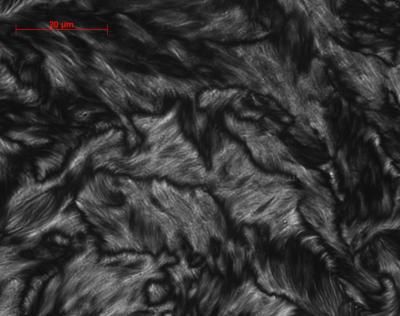Biosensing nanodevice to revolutionize health screenings
One day soon a biosensing nanodevice developed by Arizona State University researcher Wayne Frasch may eliminate long lines at airport security checkpoints and revolutionize health screenings for diseases like anthrax, cancer and antibiotic resistant Staphylococcus aureus (MRSA). Even more incredible than the device itself, is that it is based on the world's tiniest rotary motor: a biological engine measured on the order of molecules.
Frasch works with the enzyme F1-adenosine triphosphatase, better known as F1- ATPase. This enzyme, only 10 to 12 nanometers in diameter, has an axle that spins and produces torque. This tiny wonder is part of a complex of proteins key to creating energy in all living things, including photosynthesis in plants. F1-ATPase breaks down adenosine triphosphate (ATP) to adenosine diphospahte (ADP), releasing energy. It was through his own detailed study of the rotational mechanism of the F1-ATPase, which operates like a three-cylinder Mazda rotary motor, that Frasch conceived of a way to take this tiny biological powerhouse and couple it with science applications outside of the human body.
An article authored by Frasch and his colleagues in the ASU School of Life Sciences details the technology that would allow this. Their publication "Single-molecule detection of DNA via sequence-specific links between F1-ATPase motors and gold nanorod sensors" was recently published in the journal Lab on a Chip, and featured in the online journal Chemical Biology produced by the Royal Society of Chemistry.
What Frasch and his colleagues show is that the enzyme can be armed with an optical probe (gold nanorod) and manipulated to emit a signal when it detects a single molecule of target DNA. This is achieved by anchoring a quiescent F1-ATPase motor to a surface. A single strand of a reference biotinylated DNA molecule is then attached to its axle. The marker protein, biotin, on the DNA is known to bind specifically and tightly to the glycoprotein avidin, so an avidin-coated gold nanorod is then added. The avidin-nanorod attaches to the biotinylated DNA strand and forms a stable complex.
When a test solution containing a target piece of DNA is added, this DNA binds to the single complementary reference strand attached to the F1-ATPase. The DNA complex, suspended between the nanorod and the axle, forms a stiff bridge. Once ATP is added to the test solution, the F1-ATPase axle spins, and with it, the attached (now double-stranded) DNA and nanorod. The whirling nano-sized device emits a pulsing red signal that can then be detected with a microscope.
According to Frasch, the rotation discriminates fully assembled nanodevices from nonspecifically bound nanorods, resulting in a sensitivity limit of one zeptomole (600 molecules). Simply put, if it's not moving and flashing, it simply isn't relevant.
Moreover, Frasch says, "Studies with the F1-ATPase in my laboratory show that since it can detect single DNA molecules, it far exceeds the detection limits of conventional PCR [polymerase chain reaction] technology." Such a detection instrument based on the F1-ATPase enzyme would also be "faster and more portable," he adds.
See the theme worlds for related content
Topic world Synthesis
Chemical synthesis is at the heart of modern chemistry and enables the targeted production of molecules with specific properties. By combining starting materials in defined reaction conditions, chemists can create a wide range of compounds, from simple molecules to complex active ingredients.

Topic world Synthesis
Chemical synthesis is at the heart of modern chemistry and enables the targeted production of molecules with specific properties. By combining starting materials in defined reaction conditions, chemists can create a wide range of compounds, from simple molecules to complex active ingredients.


























































